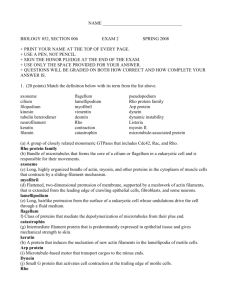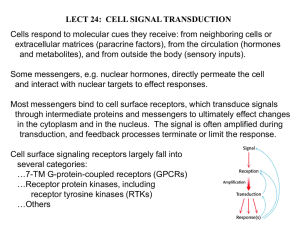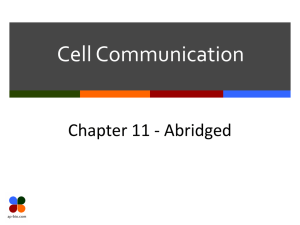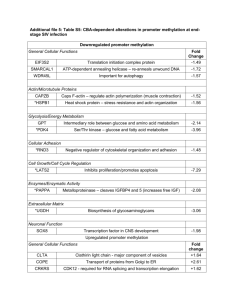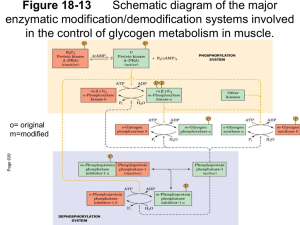1756-0381-6-17-S6
advertisement
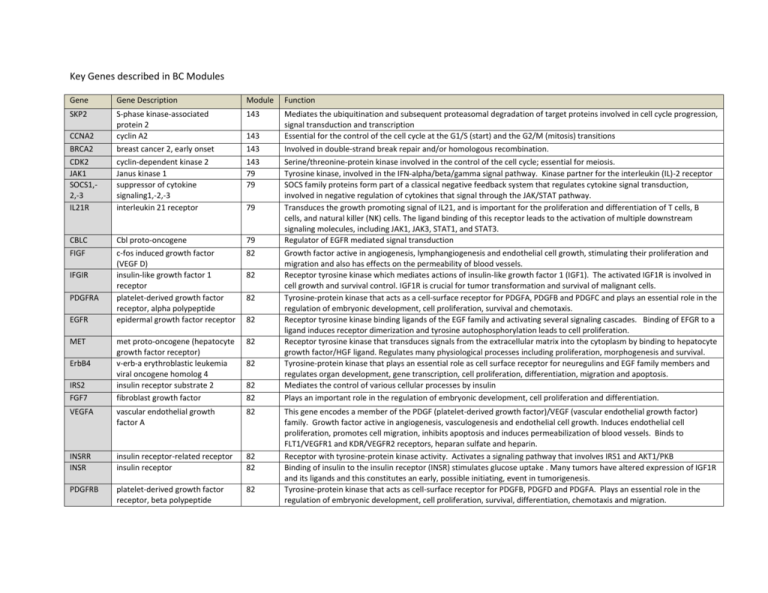
Key Genes described in BC Modules Gene Gene Description Module Function SKP2 S-phase kinase-associated protein 2 cyclin A2 breast cancer 2, early onset cyclin-dependent kinase 2 Janus kinase 1 suppressor of cytokine signaling1,-2,-3 interleukin 21 receptor 143 Cbl proto-oncogene c-fos induced growth factor (VEGF D) insulin-like growth factor 1 receptor platelet-derived growth factor receptor, alpha polypeptide epidermal growth factor receptor 79 82 met proto-oncogene (hepatocyte growth factor receptor) v-erb-a erythroblastic leukemia viral oncogene homolog 4 insulin receptor substrate 2 fibroblast growth factor 82 Mediates the ubiquitination and subsequent proteasomal degradation of target proteins involved in cell cycle progression, signal transduction and transcription Essential for the control of the cell cycle at the G1/S (start) and the G2/M (mitosis) transitions Involved in double-strand break repair and/or homologous recombination. Serine/threonine-protein kinase involved in the control of the cell cycle; essential for meiosis. Tyrosine kinase, involved in the IFN-alpha/beta/gamma signal pathway. Kinase partner for the interleukin (IL)-2 receptor SOCS family proteins form part of a classical negative feedback system that regulates cytokine signal transduction, involved in negative regulation of cytokines that signal through the JAK/STAT pathway. Transduces the growth promoting signal of IL21, and is important for the proliferation and differentiation of T cells, B cells, and natural killer (NK) cells. The ligand binding of this receptor leads to the activation of multiple downstream signaling molecules, including JAK1, JAK3, STAT1, and STAT3. Regulator of EGFR mediated signal transduction Growth factor active in angiogenesis, lymphangiogenesis and endothelial cell growth, stimulating their proliferation and migration and also has effects on the permeability of blood vessels. Receptor tyrosine kinase which mediates actions of insulin-like growth factor 1 (IGF1). The activated IGF1R is involved in cell growth and survival control. IGF1R is crucial for tumor transformation and survival of malignant cells. Tyrosine-protein kinase that acts as a cell-surface receptor for PDGFA, PDGFB and PDGFC and plays an essential role in the regulation of embryonic development, cell proliferation, survival and chemotaxis. Receptor tyrosine kinase binding ligands of the EGF family and activating several signaling cascades. Binding of EFGR to a ligand induces receptor dimerization and tyrosine autophosphorylation leads to cell proliferation. Receptor tyrosine kinase that transduces signals from the extracellular matrix into the cytoplasm by binding to hepatocyte growth factor/HGF ligand. Regulates many physiological processes including proliferation, morphogenesis and survival. Tyrosine-protein kinase that plays an essential role as cell surface receptor for neuregulins and EGF family members and regulates organ development, gene transcription, cell proliferation, differentiation, migration and apoptosis. Mediates the control of various cellular processes by insulin Plays an important role in the regulation of embryonic development, cell proliferation and differentiation. VEGFA vascular endothelial growth factor A 82 INSRR INSR insulin receptor-related receptor insulin receptor 82 82 PDGFRB platelet-derived growth factor receptor, beta polypeptide 82 CCNA2 BRCA2 CDK2 JAK1 SOCS1,2,-3 IL21R CBLC FIGF IFGIR PDGFRA EGFR MET ErbB4 IRS2 FGF7 143 143 143 79 79 79 82 82 82 82 82 82 This gene encodes a member of the PDGF (platelet-derived growth factor)/VEGF (vascular endothelial growth factor) family. Growth factor active in angiogenesis, vasculogenesis and endothelial cell growth. Induces endothelial cell proliferation, promotes cell migration, inhibits apoptosis and induces permeabilization of blood vessels. Binds to FLT1/VEGFR1 and KDR/VEGFR2 receptors, heparan sulfate and heparin. Receptor with tyrosine-protein kinase activity. Activates a signaling pathway that involves IRS1 and AKT1/PKB Binding of insulin to the insulin receptor (INSR) stimulates glucose uptake . Many tumors have altered expression of IGF1R and its ligands and this constitutes an early, possible initiating, event in tumorigenesis. Tyrosine-protein kinase that acts as cell-surface receptor for PDGFB, PDGFD and PDGFA. Plays an essential role in the regulation of embryonic development, cell proliferation, survival, differentiation, chemotaxis and migration. Key Genes described in HCC Modules Gene CDC7 DBF4 Gene Description cell division cycle 7 homolog DBF4 homolog Module 361 361 ORC5L origin recognition complex, subunit 5 361 CDC6 cell division cycle 6 homolog 361 MCM2,-3,4,-5,-7 IGF1 minichromosome maintenance complex component 2,-3,-4,-5,-7 insulin-like growth factor 1 (somatomedin C) insulin-degrading enzyme 361 nephroblastoma overexpressed insulin-like growth factor binding 7 ribosomal protein S6 kinase, 90kDa, polypeptide 2 429 429 ribosomal protein S6 kinase, 90kDa, polypeptide 6 dual specificity phosphatase 1, 2,-6,-9 mitogen-activated protein kinase 9,-10,-12,-14 protein tyrosine phosphatase, receptor type, R 429 FOS-like antigen, FBJ murine osteosarcoma viral oncogene B receptor-interacting serinethreonine kinase 2 SH3-domain binding protein 5 jun B proto-oncogene 414 IDE NOV IGFBP7 RPS6KA2 RPS6KA6 DUSP1,-2,6,-9 MAPK9,10,-12,-14 PTPRR FOSL1 RIPK2 SH3BP5 JUNB 429 429 429 414 414 414 414 414 414 Function Phosphorylates substrates that regulate the G1/S phase transition and DNA replication, including MCM2 and MCM3. Regulatory subunit for CDC7 which activates its kinase activity thereby playing a central role in DNA replication and cell proliferation. Required for progression of S phase. The complex CDC7-DBF4 selectively phosphorylates MCM2 and is then involved in regulating the initiation of DNA replication during cell cycle The origin recognition complex (ORC) is a highly conserved protein complex essential for the initiation of the DNA replication in eukaryotic cells. Studies in yeast demonstrated that ORC binds specifically to origins of replication and serves as a platform for the assembly of additional initiation factors such as Cdc6 and Mcm proteins. Involved in the initiation of DNA replication and s in checkpoint controls that ensure complete DNA replication before mitosis. Reported to be regulated in response to mitogenic signals and transcriptional control involving E2F proteins. The MCM2-7 complex (MCM complex) is the putative replicative helicase essential for 'once per cell cycle' DNA replication initiation and elongation in eukaryotic cells. Required for DNA replication and cell proliferation The insulin-like growth factors are structurally and functionally related to insulin but have a much higher growthpromoting activity. Plays a role in the cellular breakdown of insulin, IAPP, glucagon, bradykinin, kallidin and other peptides, and thereby plays a role in intercellular peptide signaling. Immediate-early protein likely to play a role in cell growth regulation Binds IGF-I and IGF-II with low affinity. Stimulates prostacyclin (PGI2) production and cell adhesion. Serine/threonine-protein kinase that acts downstream of ERK (MAPK1/ERK2 and MAPK3/ERK1) signaling and mediates mitogenic and stress-induced activation of transcription factors, regulates translation, and mediates cellular proliferation, survival, and differentiation. May function as tumor suppressor in epithelial ovarian cancer cells. Constitutively active serine/threonine-protein kinase that exhibits growth-factor-independent kinase activity. Participates in p53/TP53-dependent cell growth arrest signaling and plays an inhibitory role during embryogenesis These phosphatases inactivate their target kinases by dephosphorylation. They negatively regulate members of the MAPkinase superfamily (MAPK/ERK, SAPK/JNK, p38), which are associated with cellular proliferation and differentiation. MAP kinases act as an integration point for multiple biochemical signals, and are involved in a wide variety of cellular processes such as proliferation, differentiation, transcription regulation and development. PTPs are signaling molecules that regulate a variety of cellular processes including cell growth, differentiation, mitotic cycle, and oncogenic transformation. Silencing of this gene has been associated with colorectal cancer. Sequesters mitogen-activated protein kinases (MAPKs) such as MAPK1, MAPK3 and MAPK14 in the cytoplasm in an inactive form. Fos proteins interact with Jun proteins enhancing their DNA binding activity. FOS proteins have been implicated as regulators of cell proliferation, differentiation, and transformation. Serine/threonine/tyrosine kinase that plays an essential role in modulation of innate and adaptive immune responses. It is a potent activator of NF-kappaB and inducer of apoptosis in response to various stimuli. Plays a negative regulatory role in BTK-related signaling in B-cells. May be involved in BCR-induced apoptotic cell death. Transcription factor involved in regulating gene activity following the primary growth factor response. Key Genes described in CCA Modules Gene SPI1 Module 301 SPIB Gene Description spleen focus forming virus (SFFV) proviral integration oncogene Spi-B transcription factor RUNX1 runt-related transcription factor 1 301 IRF4 interferon regulatory factor 4 301 CEBPB 301 CDK1 CCAAT/enhancer binding protein (C/EBP), beta cyclin-dependent kinase 1 PBK PDZ binding kinase 144 HMGA2 FOXM1 BRSK1 high mobility group AT-hook 2 forkhead box M1 BR serine/threonine kinase 1 144 144 144 WEE1 WEE1 homolog 144 CDC25A cell division cycle 25 homolog A 144 CDC25B cell division cycle 25 homolog B 144 CDC25C cell division cycle 25 homolog C 144 YWHAB, E tyrosine 3-monooxygenase /tryptophan 5-monooxygenase activation protein, beta, -epsilon RAP1 GTPase activating protein 144 secreted frizzled-related protein 1-2 frizzled family receptor 2,-3,-5,-6, -8,-9 762 RAP1GAP SFRP1,-2 FZD2,-3,5,-6, -8,-9 301 144 144 762 Function Binds to the PU-box, a purine-rich DNA sequence that can act as a lymphoid-specific enhancer. A transcriptional activator involved in the differentiation or activation of macrophages or B-cells. Binds RNA and modulates pre-mRNA splicing. Transcriptional activator which binds to the PU-box, a purine-rich DNA sequence that can act as a lymphoid-specific enhancer. Required for B-cell receptor (BCR) signaling, necessary for normal B-cell development and antigenic stimulation Core binding factor (CBF) is a transcription factor that binds to many enhancers and promoters and is involved in normal hematopoiesis development. Chromosomal translocations are well-documented and are associated with leukemia. A member of the IRF (interferon regulatory factor) family of transcription factors, important in the regulation of interferons in response to infection by virus, and in the regulation of interferon-inducible genes. IRF4 negatively regulates Toll-like-receptor (TLR) signaling. A translocation involving this gene and the IgH may be a cause of multiple myeloma. Transcriptional activator in the regulation of genes involved in immune and inflammatory responses. Binds to an IL-1 response element in the IL-6 gene and plays a role in regulation of acute-phase reaction, inflammation and hemopoiesis. A member of the Ser/Thr protein kinase family that acts as a catalytic subunit of the protein kinase complex known as Mphase promoting factor (MPF), which is essential for G1/S and G2/M phase transitions of eukaryotic cell cycle. Phosphorylates MAP kinase p38 and may be active only in mitosis. Can form a complex with TP53, leading to TP53 destabilization and attenuation of G2/M checkpoint in response to DNA damage. A transcriptional regulator that plays an key role in the meiotic G2/M transition and in cell cycle regulation via CCNA2. Transcriptional factor regulating the expression of cell cycle genes essential for DNA replication and mitosis. Serine/threonine-protein kinase that plays a key role in neuron polarization and centrosome duplication. Phosphorylates CDC25B, CDC25C, MAPT/TAU, RIMS1, TUBG1, TUBG2 and WEE1. Involved in the DNA damage checkpoint, probably by inhibiting CDK1 activity through phosphorylation and activation of WEE1, and inhibition of CDC25B and CDC25C. A nuclear tyrosine kinase belonging to the Ser/Thr family of protein kinases. Catalyzes the inhibitory tyrosine phosphorylation of CDC2/cyclin B kinase, and appears to coordinate the transition between DNA replication and mitosis. Tyrosine protein phosphatases and is required for progression from G1 to S phase of the cell cycle. It dephosphorylates CDK1 and CDK2 and it is involved in the DNA damage response. It has oncogenic properties that are not well-understood. Tyrosine protein phosphatase required for G2/M phases of the cell cycle progression and abscission during cytokinesis. Dephosphorylates CDK1 and stimulates its kinase activity. CDC25B has oncogenic properties that are not well-understood. Tyrosine protein phosphatase required for progression of the cell cycle by activating G2 cells into prophase. Directly dephosphorylates CDK1 and activates its kinase activity. It is also thought to suppress p53-induced growth arrest. The 14-3-3 family of proteins interacts with CDC25 phosphatases, RAF1 and IRS1 proteins, suggesting a role in biochemical activities related to signal transduction, such as cell division, mitogenic signaling and regulation of insulin sensitivity. YWHAE has been implicated in the pathogenesis of small cell lung cancer. T GTPase-activating-protein (GAP) that down-regulates activity of the ras-related RAP1 protein. RAP1 plays a role in diverse processes such as cell proliferation, adhesion, differentiation, and embryogenesis. Soluble frizzled-related proteins (sFRPS)are modulators of Wnts and Wnt signaling. They regulate differentiation and cell growth. Epigenetic silencing of SFRP genes leads to deregulation of the Wnt-pathway which is associated with cancer. Most Frizzled receptors are coupled to the beta-catenin canonical signaling pathway, which leads to the activation of disheveled proteins, inhibition of GSK-3 kinase, nuclear accumulation of beta-catenin and activation of Wnt target genes.
